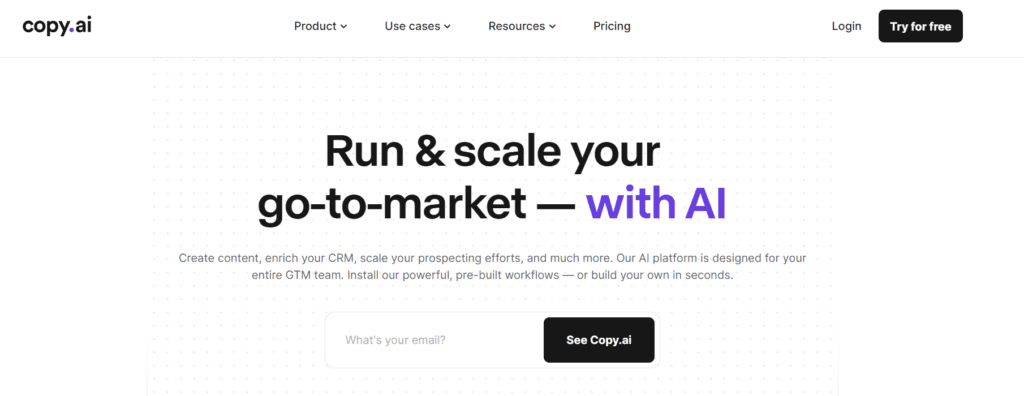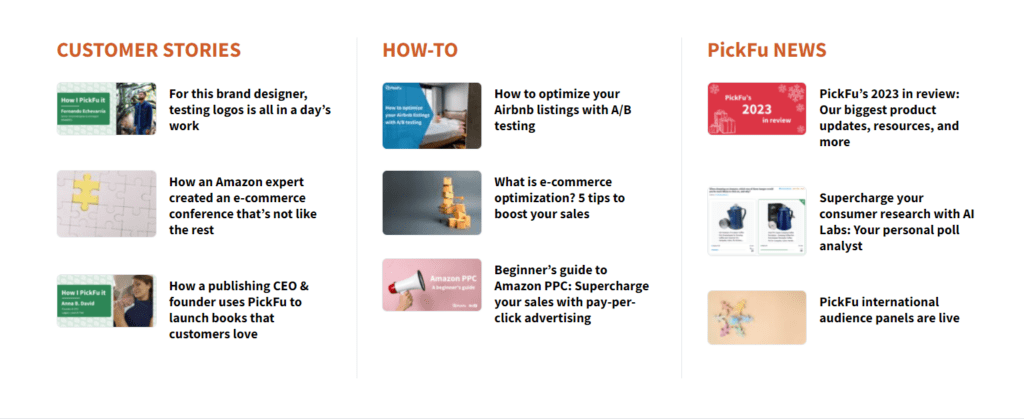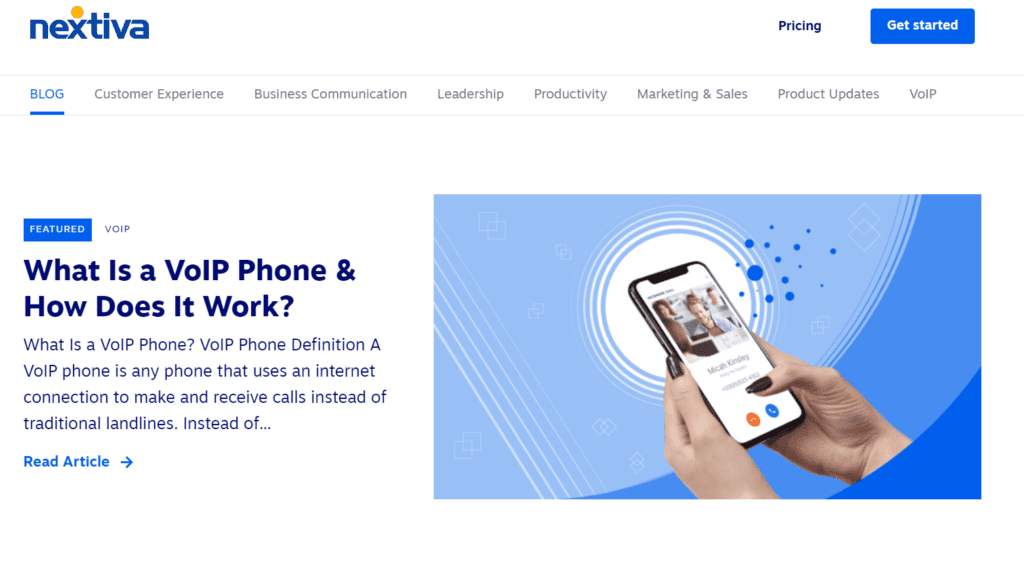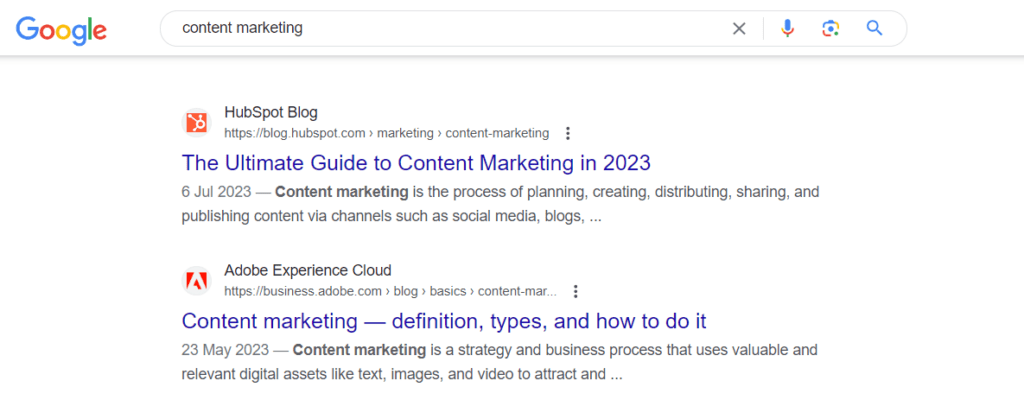Are you a B2B marketer wondering if content marketing is worth it?
Are you eager to increase traffic, get more qualified leads, and drive conversions? You’re at the right place because B2B content marketing is the key to achieving your goals.
The truth is that if you haven’t implemented a content strategy for your business yet, then you’re likely losing leads by the minute.
This post will cover everything you should know about content marketing. By the end of this post, you’ll have an argument for getting a content marketing budget and hiring a full-fledged content marketing team.
Why? So you can create content that increases your marketing efforts in the business-to-business sphere. You’ll increase organic traffic, deliver warm leads to your sales team, generate sales enablement material, and create self-help customer service to use your time and resources more effectively.
I have six years of experience in content and help content marketers learn how to get more traffic by creating high-quality content. The following represents my best knowledge so you can boost your B2B business with content.
Let’s dive in!
What is B2B Content Marketing?


B2B content marketing involves creating and distributing valuable and relevant content specifically designed for businesses.
Unlike consumer-focused content marketing, B2B content marketing is focused on attracting and engaging other businesses or, more specifically, decision-makers seeking B2B-level solutions for their enterprise needs.
Content marketing aims to generate leads, build brand awareness, establish thought leadership, and ultimately drive sales.
High-quality B2B content marketing has become crucial for brands looking to engage their target audience and build relationships too.
By applying B2B content marketing effectively, you’ll showcase your expertise and establish yourself as an authority in your industry.
Some key aspects of B2B content marketing include:
- Focused on attracting and engaging other businesses, not consumers.
- Goals are lead generation, brand awareness, and thought leadership.
- Longer sales cycles require extended nurturing through content.
- Content types like whitepapers, case studies, ebooks, and webinars.
- Highly targeted content to reach specific buyer personas with pain points – often decision-makers in other businesses.
- Directly supports sales efforts and the buyer’s journey.
Content is designed to move prospects through the sales funnel and pipeline efficiently. Ultimately, the objective is to generate new business opportunities.
Why is Content Marketing Important for B2B?
Let’s look at what makes content marketing particularly important to B2B companies.
Let’s start with the more obvious benefits of B2B content:
- Drives traffic and conversions: By creating valuable content like guides, tutorials, and product demos, B2B brands can capture viewer interest and convert them into leads.
- Lead generation: Content marketing helps nurture leads and generate quality sales opportunities at scale. For example, create whitepapers and grant access by asking users to sign up with their company email. Or hosting an exclusive and helpful webinar for executives to warm them up.
- Nurturing leads: Content helps B2B businesses continually engage and build relationships with prospects throughout their buying journey. Quality content that continues to establish trust and credibility leads to more sales-qualified leads over time.
- Support the sales team: your sales team and customer support team can answer frequently asked questions and repurpose material to save time and win over other leads and prospects.
- Brand positioning: Win over the community and make a positive impression at a social and community level.
- Builds trust and credibility: Publishing high-quality, informative content allows B2B companies to establish thought leadership and gain trust with potential customers. Rather than constant product pitches, content marketing shows clients that you care and can solve their problems.
- Captures leads earlier in the sales funnel: With content marketing, B2B brands can attract and nurture leads much earlier in the purchasing process. By addressing pain points and providing education, content engages prospects before they are ready to buy. This gives more time to build relationships.
- Increased brand awareness: Quality, relevant content that aligns with audience needs and interests helps increase visibility and establish businesses as thought leaders or experts within their industry.
- Improved SEO: Optimized content improves search engine rankings and drives more organic traffic and conversions from B2B buyers in the research and consideration stages of their buyer’s journey
A B2B content marketing strategy is the foundation of your online presence – it’s how you’ll tower over your competition and be the first choice for your target audience.
Developing a B2B Content Marketing Strategy
The entire process of creating a B2B content marketing strategy deserves its own post. For now, let’s look at a brief explanation of how to build a solid strategy for your B2B content marketing.
Understand Your Target Audience
Get started with educational research to comprehend your target audience thoroughly. Gather insights into their demographics, challenges, and needs at various stages of the buyer’s journey. This foundational knowledge will guide the creation of helpful content ideas that resonate with your audience. Understanding your audience’s pain points is especially crucial since you’ll use this information to find the right keywords and create useful blog content.
Set Clear Goals and KPIs
Articulate your marketing goals and key performance indicators (KPIs) to steer your content strategy.
Some KPIs could be:
- Driving webinar sign-ups
- Increasing email list subscriptions
- Filling your pipeline with prospects and leads
- Identifying promising leads
- Creating direct sales through SEO efforts or increasing the frequency of purchases
- Supporting existing customers with tutorials, self-help knowledge bases, and so on
Whether it’s boosting brand awareness, generating leads, or achieving sales targets, having well-defined objectives will drive your content creation towards achieving these marketing goals.
Create a Strategy Template
Your strategy template will act as a roadmap for your team and business, ensuring that the end-to-end business of content marketing happens cohesively and leads to success.
You can look for a B2B content strategy template online or simply chart your plan with the following headers:
- List your goals and objectives
- Define your target audience details
- Identify key topics where you want to showcase your authority and attract customers
- Carry out competitive research to ensure you’re on par with your competition or outdoing them
- Build a content calendar
- Define the types of content you’ll create
- Develop a brand personality
- Create style guides
- Link goals to content pieces – define CTAs and metrics
- Choose the right B2B content tools
- Start creating content
- Manage distribution and repurpose materials
- Track metrics, analyze your efforts, and make adjustments
We’ll dive into some of the most critical aspects of your B2B content plan next.
Implement a Data-Driven Approach
Before we look at content creation and distribution, it’s worth highlighting the importance of having a data-driven approach.
B2B marketing is more expensive and has more at stake.
Therefore, it’s critical to use data to build your strategy, draft content, and refine your efforts continually. Using data is important throughout your content marketing funnel. For starters:
- Run a current analysis of your blog, website, and social media. How many visitors do you have? What is your top-performing content? How do people arrive at your site from search results – and so on?
- You also need data about your audience and competition
- Finally, you need numbers to figure out how well your content is performing.
The key is to build your B2B content marketing on data and make it part of your company culture and goals.
Creating Relevant and Valuable B2B Content
The core of a content strategy is the content itself. Let’s take a look at what content creation looks like in the B2B space.


Some aspects of B2B content are as follows:
- Long-form content is essential in many cases, i.e., blog posts, papers, and more, with a word count of 1500 words and above.
- You have to create a variety of content, such as white papers, case studies, thought leadership content, blog posts, reports, presentation decks, and more. You need to expand to video content via a YouTube channel and create value-providing posts for social media. Other critical content formats include webinars, Q&As, Knowledge Bases, and so on.
- You need to do SEO (search engine optimization) keyword research and target keywords used by decision-makers and people in your space. Often, the traffic for such terms is low, but when you do convert users, the value is extremely high.
- The focus of your content needs to be on solving problems by addressing your audience’s pain points. Overall, your content needs to be educational rather than promotional.
- You need extensive content to showcase trustworthiness, credibility, and authority.
- Any blog post, article, or case study must help decision-makers see how your services link to overall business growth through revenue increase or cost-cutting measures.
- You have to invest in content marketing tools, including SEO tools, content management platforms, research tools, and AI content tools.
Next, we’ll look at integrating content creation with stages of the sales funnel as this is key to an effective B2B content strategy.
Integrating with the B2B Sales Funnel
Content marketing and the sales funnel work hand-in-hand to move prospects through the buyer’s journey.
You can attract prospects and efficiently guide them through the different stages of the funnel.
How? By aligning content marketing with the different stages. This ensures you create relevant, valuable content tailored to where prospects are in their buyer’s journey. This ultimately supports sales in converting more prospects into loyal, repeat customers.


Top of Funnel
The goal of top-of-funnel content is to raise brand awareness and attract potential customers through informative, educational content. This stage focuses on problem-awareness content to get prospects interested in your solutions. Examples include educational blogs, ebooks, infographics, whitepapers with industry insights, and thought leadership posts.
Middle of Funnel
Once prospects are aware of their pain points, mid-funnel content addresses those issues more directly. This stage provides helpful, targeted content to nurture leads, like product demos, free trials, case studies, ROI calculators, and comparisons. The aim is to convert leads into marketing-qualified leads.
Bottom of Funnel
At this point, leads are interested but need a final nudge. The bottom-of-funnel content facilitates the sale, often via promotions, free consultations, and product specs/pricing. Content showcases how your product solves their needs
Integrating content across the funnel stages and setting up lead nurturing sequences ensures you provide the right information at each touchpoint. This supports your sales process by guiding prospects smoothly toward becoming customers.
Promoting and Distributing B2B Content
Today, the problem isn’t so much creating timely content as it is getting it seen. B2B content distribution is a growing field, with even job postings dedicated to content sharing and amplification.
Once high-quality B2B content has been created, the next step is to promote and distribute it to reach the target audience. There are several key channels to consider:
- Social Media: Sharing B2B content across business-focused social platforms like LinkedIn and Twitter can expand its reach. Posting content natively on these social media platforms or sponsoring posts as ads targets relevant professional audiences. Encouraging employees to share content socially promotes it to their networks. It’s also a good way for business owners and executives to engage people by sharing thought leadership content.
- Email Marketing: Featuring new content in email newsletters and campaigns puts it directly in front of engaged email subscribers. Dedicated content promotional emails can also highlight fresh assets. Segmenting the audience allows targeting content to those most likely to find it valuable.
- Paid Promotion: Paid ad campaigns on platforms like LinkedIn and Google Ads can further amplify content. Sponsoring social posts and running search ads with links to content helps it reach a qualified audience open to B2B content. Retargeting past visitors drives them back to engage further.
- Blog/Website – Publish content directly on your company’s blog or website. This makes the content easy to find for visitors and also helps with SEO.
- Guest posting: You need to share thought leadership posts and informative content on other websites to build your online presence and drive backlinks and traffic to your business.
The key to effective content distribution is to use both owned and paid distribution channels to maximize the reach and impact of your B2B content. You also need to measure results across channels to see which performs best for your brand.
Remember, use marketing channels to expand the reach of your content. Test different promotion approaches to find the most effective distribution for each content asset. Consistently promote content over time to drive its performance.
Measuring the Success of B2B Content
Content marketing isn’t something to take up on its own account.
When all the time and effort are added up, it’s an incredibly expensive activity and one you should be able to link to worthwhile results.
A key part of your content marketing is tracking performance to understand what’s working and optimize efforts. Let’s look at the key metrics B2B marketers should monitor to gauge content success:
Traffic and Conversion Metrics
Track metrics like website visits, new visitors, time on site, and conversions to see how content impacts traffic and leads. Compare traffic before and after publishing content. Use Google Analytics goals to connect content to conversions. You’ll also need other tools but we’ll cover tools later. Website and content engagement metrics in Google Analytics like pageviews, time on page, and bounce rate. Analyze how content is performing over time and optimize underperforming pieces
Social Engagement
Social shares, clicks, comments, and follows measure content reach and engagement on social channels. Set benchmarks per platform and analyze trends. Social metrics like shares, comments, and clicks. Analyze top-performing pieces and channels to guide future content creation and promotion.
SEO Ranking Progress
Monitor keyword rankings monthly and track progress toward ranking goals. Analyze competitor movements and new opportunities. Also, use SEO to learn how to fill content gaps in the market so you’re amongst the first to attract the eye of potential customers. SEO rankings for target keywords. Track rankings over time to measure the effectiveness of optimization efforts.
Lead Generation
One of the most important ways to measure the usefulness of content marketing is by filling your pipeline with sales and converting them to leads. Your ebooks, downloadables, webinars, and blog posts should attract the right audience and inspire them to take action – like joining your email list or signing up for a demo. Set conversion goals in Google Analytics and connect content to pipeline generation.
Regularly analyzing these metrics provides insight into content resonance and business impact. You’ll also be able to optimize based on performance data to continually improve results.
Optimizing Based on Performance
We’ve covered several key aspects of your B2B content marketing efforts.
Let’s talk about optimization.
Optimization is all about identifying ways to make your content perform better. And you need analytic tools, SEO tools, and content marketing tools to help you understand this.
Some tools combine all these aspects and give you a holistic vie wof your B2B content performance. How to optimize your content marketing strategy? Let’s look into it:
- Dig into your analytics and identify your top-performing content – that is, the content driving the most traffic, leads, and sales for your business. Double down on content that is working by repromoting it or creating more content like it.
- Look for underperformers that may need improvement or retire altogether. If certain content is failing to engage visitors or drive conversions, it may not be resonating with your audience or properly aligned to the buyer’s journey. Consider reworking or removing this content by updating messaging, visuals, and calls-to-action. Or replace it entirely with new content better aligned to audience interests.
- Promote and repurpose top-performing content across multiple channels and formats. Turn blog posts into gated guides, infographics, or video content.
- Track engagement on landing pages using heat mapping tools and Google Tag Manager.
- Use Ahrefs and Semrush to check how your competition is performing so you can fill gaps they don’t address or create your own content to catch up to their efforts.
- Continuously test new content types, topics, and formats to determine what resonates most with your audience. Experiment and iterate.
- Use A/B testing to optimize things like headlines, intro copy, images, and calls-to-action. Make data-driven improvements.
- Align new content to search intent and buyer journey stage. Optimize content for each stage of the funnel – from awareness to consideration to decision.
Optimizing B2B content marketing is an ongoing process and demands strategic iteration and improvement.
The key is to analyze performance data to learn what content resonates with your audience so you can boost what’s working.
Building a Content Production Process (And Using AI)
Creating a streamlined process for content production is critical for B2B content marketing success. This involves developing an editorial calendar, establishing a content creation workflow, and managing a content team effectively. You also need to leverage AI to boost your B2B content creation and scale your work. Let’s dig in deeper:
Editorial Calendar
An editorial calendar allows you to plan out content topics and assignments in advance. Maintain a centralized editorial calendar for ideation, planning, scheduling, and tracking content.
Outline content types like blog posts, ebooks, case studies, and webinars. Identify topics based on goals, audience research, and seasonality. A calendar provides focus and keeps the team on track. You should also facilitate collaboration by allowing different teams to contribute and provide input.
Use the calendar to align content with overarching goals, campaigns, and initiatives and ensure there is no content redundancy and gaps are filled. Dedicated content calendar tools or product management tools are critical here.
Workflows
The content creation workflow outlines each step required to take a piece of content from ideation to publication. This may involve research, writing, editing, design, SEO optimization, approval, promotion, and more. Let’s break it down.
- Map out the content creation process from initial ideation to final publication. Provide templates, checklists, and clarity around roles and responsibilities.
- Establish systems for content requests, assignments, approvals, and more. Streamline processes using collaboration tools.
- Set up workflows to promote transparency and accountability at each stage. Automate repetitive tasks where possible.
- Outline expectations for timelines, deliverables, reviews, revisions, etc.
- Create workflows for promoting content and other closely related tasks.
A content marketer is worth their weight in gold to help build and maintain workflows while ensuring broader business goals are met.
Collaborate Across Teams
A key part of the content production process is ongoing communication and collaboration. It’s likely you’ll have a team of writers who will need to work with sales account managers, SEO specialists, leaders, external stakeholders, freelancers, and contractors!
You also want your content team to put their best efforts into doing SEO keyword research, brainstorming fresh ideas, and coming up with other interesting ways to make your content effective.
To encourage such collaborative and creative work, make sure you offer top communication tools like Slack. Also, provide project management tools and free training and resources to perform better.
Making sure that your team is working seamlessly is critical if you want your content production to run smoothly.
Using B2B Content Marketing Tools (Especially AI)
There’s no question that content marketing relies on tools – more so in the case of B2B content marketing.
You’ll find a full coverage of the best B2B content tools here.
Here’s a summary:
- Accelerate content creation and optimization for successful B2B marketing with specialized tools like Clearscope, Grammarly, and Yoast.
- Execute content promotion and distribution using platforms such as BuzzSumo, Outbrain, and Mailchimp.
- Streamline social media management with Hootsuite, Buffer, and Sprout Social.
- Manage analytics and reporting through Google Analytics, SEMrush, or Tableau.
- Leverage marketing automation with HubSpot, Marketo, or Pardot.
- Enhance collaboration and project management with top tools like Asana, Trello, and Slack.
And that isn’t all – you should also look into AI tools for B2B content marketing. Some of the most powerful and game-changing ones are:


- Copy AI: Uses workflows, natural language, and chat to automate and scale up content production.
- Acrolinx: An AI-powered content optimization tool that assists B2B marketers in creating content that is consistent, clear, and on-brand.
- MarketMuse: AI-based software that assists B2B marketers with content planning, optimizing for search engines, and performing competitive analyses.
- Marq (formerly Lucidpress): A collaborative, web-based design and publishing tool that helps B2B marketers easily create custom marketing materials, including brochures, reports, and other branded assets.
These are just a few of the hundreds of AI applications and tools out there. You don’t even need a dedicated B2B or content marketing platform. Start by playing around with ChatGPT to see what’s possible. It’s unlikely you’ll be able to rely on free tools so be prepared to invest – it’s worth it.
B2B Content Marketing Examples and Success Stories
B2B content marketing done well can have tremendous results for companies looking to generate leads and build their brand.
Here are some examples of companies finding success with B2B content marketing and key takeaways.
PickFu


PickFu is a user testing platform that uses blog content to attract businesses interested in user testing for a variety of purposes, including gaming development and Amazon selling optimization.
What sets PickFu apart is its targeted, insightful content that speaks directly to businesses looking for actionable solutions in real-time decision-making.
Their blogs do more than just explain their services; they educate readers on the importance of user feedback, how to extract valuable insights from this feedback, and ways to implement these learnings for tangible results.
For instance, if you’re an Amazon seller, PickFu’s content guides you through optimizing product listings with user testing data, showing real examples of increased conversions and sales.
This strategic approach to content not only attracts other businesses seeking to enhance their product through user testing but also positions PickFu as a convenient, affordable, and effective leader in the field. This is why PickFu is a great example of a smaller B2B company serving other businesses with content.
Nextiva


Let’s take a look at another B2B content marketing example – Nextiva.
It is an AI conversational marketing tool that supports unified conversations i.e. enabling customer support and sales teams to connect with audiences using chat, SMS, Video, Calls, and other means but in a unified way.
The field of unified communications is competitive and needs high-level content to attract decision-makers in firms to learn about the best AI conversational tools and how to implement them.
Its blog content, LinkedIn, and YouTube channels provide a wealth of information to their ideal customers. And their marketing efforts are a success!
With just one call center analytics post, Nextiva gets 1500 visitors a month and this has been going on for two years.
The platform combines technical knowledge with readability to provide useful information that leads to conversions.
HubSpot


One of the best examples of successful B2B content marketing comes from HubSpot.
The CRM platform successfully ranks for millions of keywords and gets traffic in the millions, too.
The key elements of its success come from providing high-quality information on various keywords and pain points. It subtly links its own company to its posts and gives users a compelling reason to sign up for their free tools, which then leads to users becoming paid customers.
John Deere – The Furrow


Here’s an interesting example – John Deere was in the content marketing game well before digital marketing was a thing.
It launched its print magazine, The Furrow, in 1894!
The idea of this magazine was to teach farmers about new agricultural methods and in the process, educate farmers and other possible customers about John Deere’s tools and machinery.
Today, the online version of The Furrow still exists, and John Deere can credit much of its success to its 19th-century content marketing efforts.
Conclusion
There you have it – almost everything you need to know about B2B content marketing so you can apply it to your business.
Whether you need to create content from scratch or refresh existing content, having a goal and the right content marketing strategies in place is certain to help you.
You’ll attract your target customers, build leads, and create a successful brand without the expense of paid advertising or other expensive means.
So, get started and implement content marketing in your B2B today!







